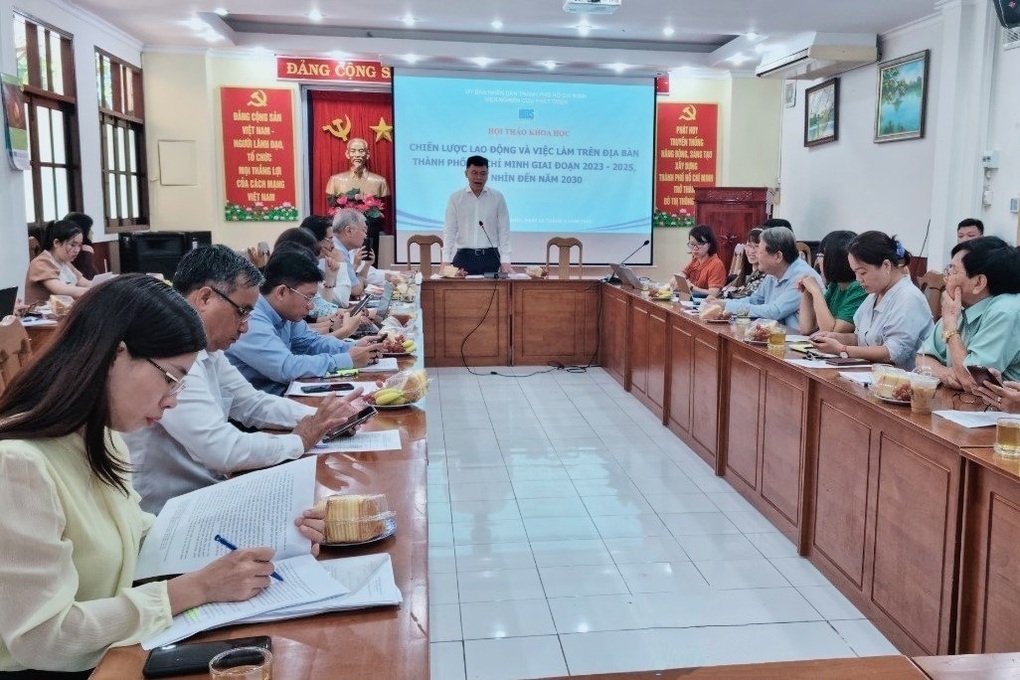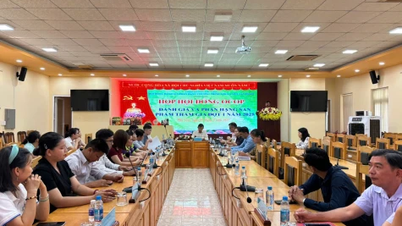Numbers down but productivity up
On September 6, the Ho Chi Minh City Institute for Development Studies (HIDS) organized a workshop on "Labor and employment strategy in Ho Chi Minh City for the period 2023 - 2025 and vision to 2030".
Speaking at the workshop, Mr. Truong Minh Huy Vu, Deputy Director of HIDS, said: "Currently, the labor market - employment in Ho Chi Minh City is having complicated developments, significantly affecting the city's overall development strategy."

Nearly 100 experts from many units in Ho Chi Minh City attended the workshop (Photo: Tung Nguyen).
According to HIDS research results, in recent years, the number of workers in industrial production enterprises in the city has tended to decrease. Specifically, in the period 2016-2020, the average decrease was 3.29%/year.
In labor-intensive industries, especially garment, footwear and related products, the number of employees decreased the most. The reason is that these industries have shifted, gradually relocated to other localities as well as increased investment in machinery and equipment innovation to increase labor productivity.
According to Mr. Truong Minh Huy Vu, in the period 2011-2020, industrial labor decreased but the industrial growth rate still maintained an average of over 6%/year. This shows that industrial labor productivity increased during this period.

Skilled workers find jobs easily and have higher incomes (Photo: Far East College).
HIDS's research team assessed: "Many international organizations believe that vocational skills will be the "new international currency" in the future labor market because they bring better competitiveness and higher labor productivity. In the current context, a skilled labor force is decisive for labor productivity."
Recent research also shows that workers who receive vocational training and education (VET) are more likely to be employed, have higher incomes and job satisfaction than those who do not receive VET training. That is, VET learners find jobs more easily and earn higher incomes.
The reason is that workers who study vocational education are better equipped with skills to adapt to new digital technologies, their employability and competitiveness with other workers are improved.
Therefore, the research team affirmed that investment in vocational training and improving vocational skills should be considered one of the focuses of the city's labor and employment strategy in the coming time.
The world of work is changing dramatically.
Speaking at the workshop, Mr. Tran Anh Tuan, Vice President of the Ho Chi Minh City Vocational Education Association, said: "The development trend of Vietnam's labor market in the coming years will have four main development trends."
The first is the increase in the number of workers on technology platforms. The second is the career shift associated with soft skills. The third is that simple labor will become weaker. The fourth is the increasing trend of "start-up, self-employment" labor.
According to Mr. Tran Anh Tuan, investment in machinery, production automation and digital technology applications will gradually become popular and change the form of employment in the labor market. The above move stems from the shift to the digital transformation period in Vietnam and will become the main trend in the digital age.
Mr. Tran Anh Tuan said: "According to statistics in Vietnam, 68% of jobs currently require knowledge of digital skills with basic digital skills, 1/5 of jobs require advanced digital skills".

Mr. Tran Anh Tuan, Vice President of Ho Chi Minh City Vocational Education Association, gave comments at the workshop (Photo: Tung Nguyen).
The strong transformation of the 4th industrial revolution has rapidly changed the demands of the world of work and the labor market. This transformation also forces management agencies to strengthen the mechanism of surveying human resource needs and have training plans to prepare a suitable workforce for the city's economic development.
According to the Vice President of the Ho Chi Minh City Vocational Education Association, today’s knowledge and skills can quickly become obsolete tomorrow. Industries that use a lot of low-skilled labor will lose their competitive advantage. A part of the low-skilled labor force will be laid off…
"Therefore, the approach to the open education and training system has undergone fundamental changes. From specialized training, it has shifted to multi-skill training for workers so that they can cope with those challenges," said Mr. Tuan.
However, Mr. Tran Anh Tuan assessed that the above changes are still not enough, the education and training system has not yet caught up with the trends of the labor market, especially in the field of vocational education.
He analyzed: "The current training program is still not flexible, the content is not suitable for the needs and trends of the labor market in the 4th industrial revolution."
"Improving training quality is an important solution to increase labor productivity and improve the quality of human resources," the Vice President of the Ho Chi Minh City Vocational Education Association emphasized.
Source link



![[Photo] Prime Minister Pham Minh Chinh chairs Government Standing Committee meeting on Gia Binh airport project](https://vphoto.vietnam.vn/thumb/1200x675/vietnam/resource/IMAGE/2025/5/10/6d3bef55258d417b9bca53fbefd4aeee)
































































































Comment (0)